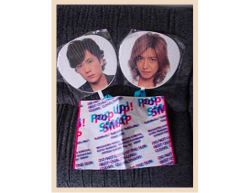
Todd Jay Leonard, Blog


As a teenager, I was never that keen about attending "rock" concerts. In college, I only went to a couple. I was never crazy about any one group, musician or singer that compelled me to be a "fan."
However, since living in Japan I have gone to a number of concerts. Recently, I traveled to Tokyo with a gaggle of friends who truly are "fans" to attend a "pop" concert of a boy band that has been around for nearly two decades. They were in their early teens when they first performed as a group.
The group is called SMAP, and it is made up of five guys who have parlayed their teenage dream of pop stardom into a huge, multifaceted - almost cultlike - mega-industry.
Too often, teenybopper groups quickly get classified into the "one-hit wonder" category because after their initial burst of stardom, they fade into oblivion, never to be heard from again.
Not these guys. They have maintained their "hotness" throughout the years, progressively expanding their fan base with each new generation that comes into contact with their music. Rarely can you pick up a magazine or turn a channel on television and not see at least one, if not all, of these guys. They are featured in commercials, act in TV dramas, host TV shows, appear in movies, write books and, of course, sell a lot of music CDs and DVDs.
I was a bit worried at first when my friend called to ask if I would go with her. I didn't want us to be lost in a crowd of teenagers, the only middle-aged people in the audience - two old codgers amid a sea of young kids screaming their heads off.
Instead, we were just two early-middle-aged people among tens of thousands of 30- to 50-year-old women screaming their heads off. Of course, there were young children there as well, and teenagers, university students, young adults ... but overwhelmingly, the crowd consisted of older women. There even were elderly people teetering around the venue with canes in hand.
My friend is a big fan of this group, and she came to the concert very prepared. I was strictly instructed that I had to wear a red shirt and hat. Each of us was color coordinated in an "official" SMAP color that represented one of the five group members.
She wore pink; another person in our group wore green; and another blue. It seems that the hard-core fans of this group know this fact. I was clueless and felt a bit silly, but once I arrived, I realized how serious these fans were about supporting their favorite group member by wearing the color associated with him.
Since the color of a person's clothing signals which group member you like the best, those who can't decide on just one member will mix the colors, rooting for their "favorites."
The particular performer for whom I was dressed in red is Takuya Kimura, better known by his legions of fans as "Kimitaku" (a combination of his last and first names). Before the concert, we had to arrive early in order to stand in line to view and buy the many "goods" associated with the group. My friend had a "wish" list from friends who weren't lucky enough to get one of the more than 50,000 tickets sold for that particular show.
The official SMAP products include anything from washcloths and towels to flashlights and oversized hand fans that feature each member's face prominently, but separately. Which means … many of these women opted to buy all five in order to have a complete set. Lighted flashlights were also sold, and I think every person in the arena had one. You do the math. Somebody made a whole lot of money on this concert tour.
During the actual concert, each song seemed to have its own particular hand movements that went along with the lyrics. Seemingly everyone knew this but me; I tried to keep up the best I could, mimicking everyone else around me.
It was a spectacle to behold - 50,000 screaming fans moving their fans and lights in unison throughout the entire 3-hour concert.
The boys do know how to put on a show. Actually, they are much better performers than they are singers, in my opinion. It's the whole package, though, that makes them so popular, causing normally demure and reserved Japanese women to scream like banshees.
The show featured pyrotechnics, loud booms, smoke and a jungle-themed stage setting with a waterfall. Two cranes lifted the members up into the ethers of the arena so those poor souls stuck in the hinterlands could have a closer look at their favorite group members.
We were on the main floor, next to the side stage, which gave us a very close look at the members. This thrilled my friend to pieces. At one point, she held up a sign that said "thank you" and one of the members acknowledged her with a thumb's-up gesture. I thought she was going to faint.
Initially, the group entered the arena from the ceiling, sliding down steel cables to the floor. For the finale, they rode around the entire stadium floor in cherrypicker-like contraptions that hoisted them up and down to make eye contact with as many people as they could. During their costume changes, the audience was treated to a mini-movie in 3-D. Each audience member had a set of 3-D glasses with which to view the program.
As thrilling as the concert was, though, what really impressed me was the politeness of the fans. Unlike American concerts, where people push and shove trying to get closer to the stage, each fan at the SMAP concert stayed in his/her seat, never encroaching upon another's space. Although there were security guards and staff standing around everywhere, they had nothing to do, really, because no one tried to run onto the stage, jump the barrier or do anything that wasn't permitted. I witnessed not one instance of tomfoolery being perpetrated by a dumb fan. Everyone just enjoyed the concert from the seat that was assigned to them.
After the concert finished, with everyone still whipped up into a crazed fervor, the stadium lights came on and an announcer politely asked everyone to stay seated until he released the section they were sitting in. From the top to the bottom, 50,000 people filed out quietly and in an orderly manner. This was the most amazing part for me - tens of thousands of people waiting patiently as each section was released, then standing and calmly exiting the arena. There was no pushing, shoving or jostling of any sort.
I can't imagine the reaction of a crowd at an American event with the same number of people in attendance being asked to stay seated until told they could leave. People would be incensed that they couldn't leave immediately. Japanese people don't usually have that overpowering urge to get out as quickly as possible in these types of situations. For instance, after a film finishes in a theater, Japanese people nearly all stay seated until the very last credit rolls up the screen and the house lights come on. In the United States, a film is barely finished when people start rustling about, crawling over other people, trying to exit the theater as quickly as possible. It's a "beat the crowd" mentality - even if it means standing in line to get out the door or sitting in your car waiting for traffic to clear.
I have now become so accustomed to sitting in a theater until all the credits have finished that when I go to a movie in the U.S., family and friends think it strange to sit and read every credit that passes by. Sometimes I am left sitting alone in the theater … which is fine by me.
By TODD JAY LEONARD
Columnist
Concerts not just for teens
Japanese fans’ enthusiasm rivaled only by their courtesy
Monday, December 4 , 2006







